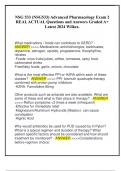NSG 533 (NSG533) Advanced Pharmacology Exam 2
REAL ACTUAL Questions and Answers Graded A+
Latest 2024 Wilkes.
What medications / foods can contribute to GERD? -
ANSWER >>>>-Medications: anticholinergics, barbituates,
dopamine, estrogen, opioids, progesterone, theophylline,
nitrates
-Foods: cirus fruits/juices, coffee, tomatoes, spicy food,
carbonated drinks
Fried/fatty foods, garlic, onions, chocolate
What is the most effective PPI or H2RA within each of these
classes? - ANSWER >>>>-PPI- bismuth quadruple therapy
combined with proton pump inhibitors
-H2RA- Famotidine 80mg
Other products such as antacids are also available. What are
some of these and what is their place in therapy? - ANSWER
>>>>-Reflux symptoms <2 times a week (infrequent)
-Effective for immediate relief
-Magnesium/Aluminum Hydroxide (Maalox)- can cause
constipation
-Alginic Acid
Why would antibiotics be used for PUD caused by H Pylori?
What is a typical regimen and duration of therapy? What
patient specific factors should be considered and how should
treatment be monitored? - ANSWER >>>>Considerations
before regimen choice:
,-penicillin allergy
-previous exposure to macroglide antibiotics
Strongest Reccomendation:
-Bismuth Quadruple Therapy 10-14 days
*do not drink alcohol w/ metronidazole*
-Salvage regimen should be different than first regimen
Who would be a candidate for prophylaxis of NSAID induced
ulcer and what agents are appropriate? What if the patient is
on cardio-protective (low dose) aspirin? What if an NSAID
induced ulcer does develop. How should it be treated? -
ANSWER >>>>Candidate:
-Candidates: Chronic Nsaid Use, Hx ulcers, Zollinger-Ellison
Prevention Treatment- PPI, standard doses (most effective &
best tolerated), Misoprostol (better than H2RA's, No
Pregnancy)
What if an NSAID induced ulcer does develop. How should it
be treated? - ANSWER >>>>Ulcer Treatment-
-PPI (most effective)
-H2RA (Famotidone 40mg daily)
-Sucralfate (binding paste, requires multiple doses, adverse
med reactions, abdominal side effects)
Who is a candidate for stress ulcer prophylaxis (SUP)? -
ANSWER >>>>-ICU patients
-Trauma, including spinal cord injuries
-Mechanical ventilation
-Thermal injuries >35% (almost half the body)
Of the agents available to control the complications of
diabetes mellitus, cardiovascular drugs, and particularly ACE
inhibitors, have a pre-eminent place. Experimental and
,epidemiological data suggest that activation of the renin-
angiotensin-aldosterone system plays an important role in
increasing in the micro- and macrovascular complications in
patients with diabetes mellitus. Not only are ACE inhibitors
potent antihypertensive agents but there is a growing body of
data indicating that also they have a specific 'organ-protective'
effect. For the same degree of blood pressure control,
compared with other antihypertensive agents, ACE inhibitors
demonstrate function and tissue protection of considered
organs. ACE inhibitors have been reported to improve kidney,
heart, and to a lesser extent, eye and peripheral nerve
function of patients with diabetes mellitus. These favorable
effects are the result of inhibition of bo - ANSWER >>>>
There is a "compelling" indication in patients with
hypertension and DM. These should be the 1st class of
antihypertensive medications used in those with DM + HTN
Recommended for the treatment of the patient with CKD
(modestly elevated (30-299 mg/24 h) or higher levels (>300
mg/24 h) of urinary albumin excretion), even in those without
DM
Delay progression of nephropathy in Type 1 with or without
HTN and any degree of albuminuria
Delay progression of nephropathy in Type 2 with or without
HTN and microalbuminuriaReduce development of
microalbuminuria (kidney disease) in Type 2 with or without
HTN
ARBs are considered a reasonable alternative for those
intolerant of ACEI - ANSWER >>>>
Cardioprotective dose ASA (IE baby aspirin or clopidrogel as
alternative)For SECONDARY PREVENTION of CV Events-
Use in ALL diabetics with CV diseaseFor PRIMARY
, PREVENTION of CV EventsUSE in: high CV risk patients (10-
yr CV risk > 10%) - Typically: male > 50 yo or female >60 yo
with 1 additional major risk factor (FH of CVD, HTN, smoker,
dyslipidemia or albuminuria)MAY consider: intermediate CV
risk patrients 10-yr CV risk of 5-10%) - younger patients with 1
or more risk factors, older patients with no risk factorsNOT
recommended: low CV risk patients - men <50 yo or women
<60 yo without major CV risk factors or 10-yr CV risk <
5%Note - Many authorities consider DM to be an ASCVD risk
equivalentThis is basically everyone with DM - ANSWER
>>>>
What are the goals set by ACE /ACCE and are they written in
stone for all patients? - ANSWER >>>>Primary target for
glycemic control is HbA1C
Individualize HbA1C goal - based on...Duration of DMAge/life
expectancyComorbid conditions
Known CVD or advanced comorbid conditionsHypoglycemic
unawareness
Individual patient considerations
Please note when transitioning from oral therapy for type II
DM to insulin, metformin is retained! Secretagogues are
discontinued possibly when basal insulin is initiated, but
definitely when prandial (fast/rapid) insulin is to be added -
ANSWER >>>>Options to add to basal insulin for prandial
coverage...
Fast-acting insulin
DPP-4 inhibitors
Incretin mimetics
Glinides
Alpha-glucosidase inhibitors
Colesevelam




